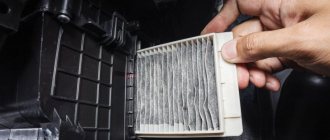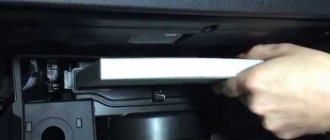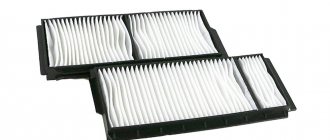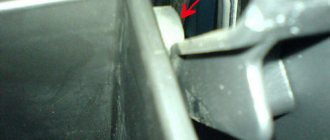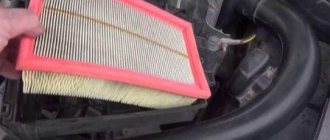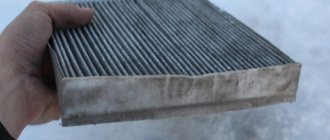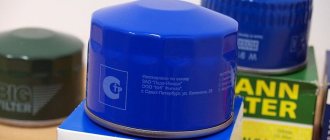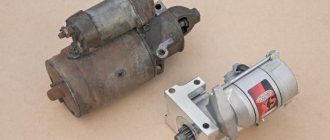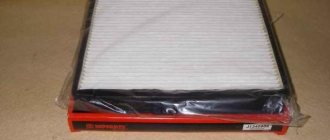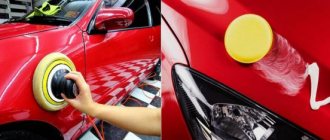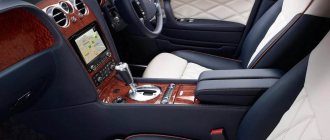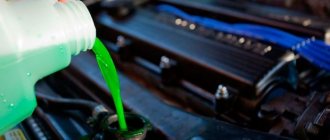Cabin filters have appeared on the shelves of auto stores quite recently. That is why today not all car owners understand how important this element is in creating a comfortable air environment in the cabin, and how it ensures their personal safety. This happens due to the fact that most motorists do not have a clear understanding of the operating principle of the cabin filter. Very often, drivers consider such a device unnecessary in a car and treat it appropriately: they save on buying and replacing it, and try to wash or clean the old one instead of purchasing a new filter.
Meanwhile, cabin filters are extremely important and their presence should be considered not as a luxury item, but as a required safety feature. In this regard, developers are constantly improving these cleaning elements, and if previously there was only one type of filter on sale - a regular, dust filter, now its carbon “colleague” has also appeared.
Many car owners wonder which filter is best to install in their car, what are the pros and cons of each type? In this article we will try to answer this question, as well as reveal the principles of operation of both types of filters.
Design and purpose of an anti-dust (conventional) filter
The anti-dust or anti-allergen filter is a white rectangle made of synthetic or cellulose fiber with corrugated paper laid in rows. The density of the filter material is lower than that of the paper element in the air filter - the vacuum in the ventilation system is much lower than that formed in the intake manifold during suction. The dust filter, in addition to dust, has the ability to retain other particles of contaminants, such as soot, rubber, pollen and heavy chemical compounds. If the filter fibers have been chlorinated, it will have the ability to neutralize certain types of dangerous bacteria. If the filter uses synthetic fiber, then, among other functions, it can attract small particles through electrical voltage.
Advantages:
- Possibility of using the fan, even when driving in a tunnel or standing in a traffic jam;
- Reduced “sweating” of glass;
- Filtration of large and small debris;
- Filtration of pollen, spores and bacteria.
- Low cost.
Flaws:
- Does not retain hazardous toxic substances.
- Does not cope with foreign odors.
Design and purpose of a carbon filter
Carbon filters are an improved continuation of dust filters. They have a multi-layer design, which consists of layers of fiber and activated carbon. The first layer is a coarse filtrate, which retains large-sized debris contained in the air. The second layer is made of microfiber, which absorbs small particles that can enter the lungs. The third layer, separated from the first two, is a layer of molded activated carbon, famous for its absorbent properties. It removes unpleasant odors and dangerous volatile compounds - sulfur oxides, nitrogen oxides and substances of benzene, phenolic and other groups. Most of these compounds cause irreparable harm to human health, being carcinogens. When they are combined with coal, absorption or absorption of harmful substances occurs with partial neutralization.
Advantages:
- Possibility of using a blower fan, even when driving in a tunnel or traffic jam;
- Reduced “sweating” of glass;
- Filtration of all harmful substances by 95%;
- Ozone, harmful to humans, is converted into oxygen;
- Activated carbon removes unpleasant odors and harmful volatile compounds.
Flaws:
- High price
So which filter is better?
Not so long ago, carbon versions appeared in the assortment of cabin filter manufacturers at a price 1.5-2 times higher than their anti-dust counterparts. A completely logical question arises: how justified is the installation of a carbon filter?
As we can see from a comparison of the advantages and disadvantages of both types of cabin filters, carbon is superior to anti-dust filters in several respects. But, let’s figure it out, maybe these parameters are not so significant and it’s better to buy a regular filter than to overpay for a carbon one?
First of all, you need to identify the tasks that the cabin filter should perform. It must capture all types of contaminants - dust, small insects, etc., to ensure a comfortable ride not only for the driver, but also for the passenger. And if ideally, then it will retain chemical compounds dissolved in the air, as well as harmful microorganisms. The bottom line is that large gaseous compounds based on hydrocarbons, such as methanol, ethylene and more complex organic substances, are concentrated in large cities and highways.
Unfortunately, the cabin dust filter does not trap these gases, unlike a carbon one. The layer with activated carbon has a great ability to retain and absorb impurities of various kinds. That is, it captures not only large particles of pollution, but also heavy compounds that are in a gaseous state.
Based on the clinical studies conducted, we can say with complete confidence that some organic compounds present in car exhaust gases and urban smog have a detrimental effect not only on the general state of health, but also on the perception of it. An insufficient amount of oxygen leads to slower reactions, increased irritability, nausea, and even disorders in the human nervous system. Naturally, every such trip becomes dangerous. And only a carbon filter can help cope with this problem. If the mass of activated carbon and its placement meet current standards, then such a cabin filter can reduce the content of harmful impurities in the air by 2.5-3.5 times.
Special mention should be made about chemical compounds such as nitrogen dioxide and nitric oxide. Carbon filters are most active in relation to these elements and are capable of reducing their content in the cabin by tens of times. This makes carbon filters even more necessary, as nitrogen oxides have a detrimental effect on mucous membranes, burning eyes and drying out the nasopharynx and mouth. Such exposure not only causes discomfort, but also harms health and provokes emergency situations.
What it is
For a modern car, the cabin filter is a cleaning device. This is a special element through which the air flow entering through the air ducts passes.
It is due to the presence of a filter that there are no harmful particles, dust, exhaust gases, etc. inside the car. The quality and efficiency of the filter plays a particularly important role for residents of large cities. A huge number of cars, heavy traffic and the active flow of exhaust gases into the air ducts can create extremely unfavorable conditions in the cabin.
Most cabin filters are rectangular in shape. There are filter elements inside it. Some have adsorbent layers, where activated carbon is predominantly used. It is these elements that are responsible for air filtration.
Changing the filter requires a minimum of time and effort on most cars. Although there are some car models where automakers have not provided easy access to the cartridge. That's why sometimes you have to disassemble the center console. But in most cases, getting to the purifier is quite simple.
Much to our chagrin, many drivers do not attach much importance to cabin filters. They don’t change them at all, or do it extremely rarely. But here it is important to understand that a clogged filter negatively affects not only the air quality in the cabin, but also the operation of the car itself.
If you do not change the cartridge in time, there will be a serious problem with the supply of clean air inside the machine. The driver and passengers will be the first to feel discomfort. After wear, the filter begins to actively accumulate moisture, air circulation is disrupted, which leads to fogging of the glass. Moisture combined with dust and dirt create ideal conditions for the proliferation of bacteria and various microorganisms. That’s why you can often see mold and mildew forming on old filters. People breathe all this.
In addition to conventional and carbon filters, you can now find electrostatic and antibacterial devices. In the first case, dust settles on special electrified surfaces. And antibacterial filters protect against harmful microorganisms, bacteria and germs. This is achieved through the use of special components in the filter elements. Such filters do a good job of protecting against unpleasant odors. Moreover, they continue to perform their function even after the end of their service life.
But still, motorists prefer proven standard and adsorbing air purifiers in the cabin. There is a certain difference between them, which led to the emergence of such active disputes.
Carbon filter service life
To summarize, we can now say without a doubt that a carbon filter is much better than a dust filter. And if our conclusions have convinced you, then most likely you will ask the question - what is the service life of the cabin filter? There are two criteria here that need to be taken into account. The carbon filter supports two functions at once - absorbs dust and volatile gases. If it is used in the summer, the car is driven on dirt roads, then the service life will be approximately the same as that of the air filter. If the car owner rarely drives his car or uses it in urban conditions, then the service life of the filter increases - the activated carbon is depleted in about 3-4 months, and the filter element itself can perform its functions for a long time.
At this moment we can absolutely say that in the current environmental situation, the cabin filter has become an integral part of the car.
We present you the following video that will help you replace the cabin filter yourself:
Cabin filters have appeared on the shelves of auto stores quite recently. That is why today not all car owners understand how important this element is in creating a comfortable air environment in the cabin, and how it ensures their personal safety. This happens due to the fact that most motorists do not have a clear understanding of the operating principle of the cabin filter. Very often, drivers consider such a device unnecessary in a car and treat it appropriately: they save on buying and replacing it, and try to wash or clean the old one instead of purchasing a new filter.
Meanwhile, cabin filters are extremely important and their presence should be considered not as a luxury item, but as a required safety feature. In this regard, developers are constantly improving these cleaning elements, and if previously there was only one type of filter on sale - a regular, dust filter, now its carbon “colleague” has also appeared.
Many car owners wonder which filter is best to install in their car, what are the pros and cons of each type? In this article we will try to answer this question, as well as reveal the principles of operation of both types of filters.
When to change the cabin filter, mileage
As a rule, the manufacturer establishes a schedule for replacing the cabin filter within 15,000 km . You can follow his recommendations, but, understanding that the car is operated in a metropolis, industrial zone or high concentration of dust, we can safely divide the scheduled mileage by two. Experienced drivers who spend all day behind the wheel recommend replacing it once every 6-8 thousand km or twice a year, for example, along with replacing the oil filter and engine oil.
Interesting on the topic: Review of Ford Focus Active 2021. The same, but with mother-of-pearl buttons
However, there are obvious symptoms of a clogged cabin air filter that are fairly easy to notice:
- The windows in the cabin began to fog up. This means that air circulation is impaired and it is time to change the cabin filter.
- The appearance of unpleasant odors.
- Poor air flow from the heater or air conditioner.
- Dust falls on the surface of the front panel and the inside of the interior glass.
We change the cabin filter when at least one of these symptoms appears.
Design and purpose of an anti-dust (conventional) filter
The anti-dust or anti-allergen filter is a white rectangle made of synthetic or cellulose fiber with corrugated paper laid in rows. The density of the filter material is lower than that of the paper element in the air filter - the vacuum in the ventilation system is much lower than what is formed in the intake manifold during suction. The dust filter, in addition to dust, has the ability to retain other particles of contaminants, such as soot, rubber, pollen and heavy chemical compounds. If the filter fibers have been chlorinated, it will have the ability to neutralize certain types of dangerous bacteria. If the filter uses synthetic fiber, then, among other functions, it can attract small particles through electrical voltage.
Advantages:
- Possibility of using the fan, even when driving in a tunnel or standing in a traffic jam;
- Reduced “sweating” of glass;
- Filtration of large and small debris;
- Filtration of pollen, spores and bacteria.
- Low cost.
Flaws:
- Does not retain hazardous toxic substances.
- Does not cope with foreign odors.
Design and purpose of a carbon filter
Carbon filters are an improved continuation of dust filters. They have a multi-layer design, which consists of layers of fiber and activated carbon. The first layer is a coarse filtrate, which retains large-sized debris contained in the air. The second layer is made of microfiber, which absorbs small particles that can enter the lungs. The third layer, separated from the first two, is a layer of molded activated carbon, famous for its absorbent properties. It removes unpleasant odors and dangerous volatile compounds - sulfur oxides, nitrogen oxides and substances of benzene, phenolic and other groups. Most of these compounds cause irreparable harm to human health, being carcinogens. When they are combined with coal, absorption or absorption of harmful substances occurs with partial neutralization.
Advantages:
- Possibility of using a blower fan, even when driving in a tunnel or traffic jam;
- Reduced “sweating” of glass;
- Filtration of all harmful substances by 95%;
- Ozone, harmful to humans, is converted into oxygen;
- Activated carbon removes unpleasant odors and harmful volatile compounds.
Flaws:
- High price
So which filter is better?
Not so long ago, carbon versions appeared in the assortment of cabin filter manufacturers at a price 1.5-2 times higher than their anti-dust counterparts. A completely logical question arises: how justified is the installation of a carbon filter?
As we can see from a comparison of the advantages and disadvantages of both types of cabin filters, carbon is superior to anti-dust filters in several respects. But, let’s figure it out, maybe these parameters are not so significant and it’s better to purchase a regular filter than to overpay for a carbon one?
First of all, you need to identify the tasks that the cabin filter should perform. It must capture all types of contaminants - dust, small insects, etc., to ensure a comfortable ride not only for the driver, but also for the passenger. And if ideally, then it will retain chemical compounds dissolved in the air, as well as harmful microorganisms. The bottom line is that large gaseous compounds based on hydrocarbons, such as methanol, ethylene and more complex organic substances, are concentrated in large cities and highways.
Unfortunately, the cabin dust filter does not trap these gases, unlike a carbon one. The layer with activated carbon has a great ability to retain and absorb impurities of various kinds. That is, it captures not only large particles of pollution, but also heavy compounds that are in a gaseous state.
Based on the clinical studies conducted, we can say with complete confidence that some organic compounds present in car exhaust gases and urban smog have a detrimental effect not only on the general state of health, but also on the perception of it. An insufficient amount of oxygen leads to slower reactions, increased irritability, nausea, and even disorders in the human nervous system. Naturally, every such trip becomes dangerous. And only a carbon filter can help cope with this problem. If the mass of activated carbon and its placement meet current standards, then such a cabin filter can reduce the content of harmful impurities in the air by 2.5-3.5 times.
Special mention should be made about chemical compounds such as nitrogen dioxide and nitric oxide. Carbon filters are most active in relation to these elements and are capable of reducing their content in the cabin by tens of times. This makes carbon filters even more necessary, as nitrogen oxides have a detrimental effect on mucous membranes, burning eyes and drying out the nasopharynx and mouth. Such exposure not only causes discomfort, but also harms health and provokes emergency situations.
The best dust cabin filters
Conventional cabin dust filters are made of a plastic frame, inside of which a block of corrugated paper is placed. The density of the material allows air to pass through, but traps dust and pollen. This is the cheapest option to protect the interior from small debris.
CAT SC - there are models for all cars
- This is the best cabin filter for the price from a Novosibirsk company that sells Chinese spare parts throughout Russia.
- The company supplies cleaning elements for all Japanese and Korean cars, which are fully consistent with the original ones, but cost three times less.
- If it is difficult to find a filter in the catalog for a specific model, then users in the reviews advise simply putting ST in front of the article number of your original cleaning element.
- Pros:
- unlike original products, two blocks are produced in one piece (without a partition), which increases throughput;
- Fully sized for different car models;
- cost from 250 rubles;
- In reviews, drivers note that they breathe well with it.
Minuses:
- normally retains dust only for 6 months;
- when water gets in from storm drains, it quickly fails;
- does not retain moisture from outside.
Sakura CA - the best for Toyota
This cabin dust filter is the best for Japanese Toyota cars. The product is a product from a company in Japan, but is produced at production facilities in Indonesia, so it costs less than the original.
- The white packaging with red stripes always indicates the original part number of the filter, as well as the original Toyota model number to which it fits.
- User reviews like that the product is additionally packaged in a sealed film, so it does not absorb moisture during long-term storage in a warehouse or during delivery.
- Pros:
- thick paper that does not get wet quickly and holds dust well;
- a rigid plastic frame maintains its shape and prevents gaps between the filter and the seat;
- slight flexibility of the frame facilitates easy insertion into the grooves during installation;
- can always be distinguished from a counterfeit by additionally marking the article number and place of manufacture on the body of the filter itself;
- the manufacturer covers all lines of the Japanese concern Toyota, including Corolla, Land Cruiser, RAV4;
- the product is certified;
- manufactured using Japanese technology;
- The kit includes brief instructions with photographs for installation for a specific car model;
- The paper thickness is similar to the original product.
Minuses:
- the price for a simple dust filter from 500 rubles still remains high.
Valeo - with extra thick paper
This is the best cabin filter in terms of paper density. Although there is only one layer for protection, the fibers are so close that they trap even fine dust when driving along a dirt road or next to a wheat field being harvested. Users in reviews note that its paper does not shine through when held up to the light.
Pros:
- French manufacturer with a proven reputation;
- high cleaning;
- the seams are well glued;
- durable frame.
Minuses:
- It is not easy to get products from this company everywhere - you may have to wait weeks for delivery;
- comes in a box but without a bag inside;
- all inscriptions on the box are in foreign languages (produced for export to six countries).
AMD is a leader in quality
The highest quality air filters in our rating are products from AMD. The products are manufactured in Korea and have a wide range suitable for many car brands.
The quality of the filters lies in a rigid housing, often consisting of three compartments, which increases the strength of the frame. The perimeter of the filter is covered with foam rubber, so it is installed tightly in place, eliminating rattling.
Pros:
- reliable packaging in mica;
- exact matching of dimensions to seats;
- the filter element is glued without smudges;
- users in reviews share that they do not feel the difference between it and more expensive carbon filters;
- plastic has no odor;
- cost from 200 rubles.
Minuses:
- does not filter the smell of exhaust gases;
- Inside the product is without film.
The best carbon cabin filters
Carbon cabin filters are made of synthetic fibers with a coarse and thin layer that trap large and small debris.
The element device includes another layer of molded activated carbon, which has absorbent properties.
The material retains moisture and partially neutralizes unpleasant external odors. Here is a rating of products in this category with positive reviews and characteristics.
Mann CUK - decent quality
In RuNet, products from the manufacturer Mann have the most positive reviews. Cleaning elements produced in Germany are equipped with a durable frame that helps maintain the correct shape and tightness despite long-term use. The CUK series is the best for Audi and Bentley cars, but such filters are expensive.
Pros:
- produced directly in Germany;
- have a thickness of 31 mm for reliable absorption of small particles;
- certified by Eurasian Conformity;
- fits perfectly in place of the original filter for most car models;
- there is a noticeable increase in the delay period for dust settling on the dashboard and dashboard;
- a thick layer of coal effectively absorbs moisture and windows in the cabin are less likely to sweat;
- durable plastic on the body;
- many drivers have been using Mann filters for 10 years, changing them in accordance with the regulations;
- eliminates unpleasant odor.
Minuses:
- cost from 1500 rubles.
TSN - optimal in cost
This product is rated from a Russian manufacturer. The cabin filter is the best in terms of cost, given that it has a thick layer of activated carbon for adsorption.
Coal dust is sprinkled over the entire surface of the cellulose corrugated material. The product has many positive reviews.
Pros:
- the height of the cleaning element is 40 mm, which promotes high-quality filtration of the air flow passing into the cabin;
- sealed in film, which makes the sealed storage period indefinite;
- the label always indicates a code indicating which cars it is suitable for;
- There is an arrow on the body that helps you understand which side to insert the filter into the cassette;
- the accordion of paper fits tightly to each other and reliably retains small debris;
- costs four times less than the original for Korean models.
Minuses:
- comes in plastic packaging, not in a box, so when ordering from an online store, it may be damaged during transportation;
- optimal operation for the first 4 months (in summer).
Do you want to receive up-to-date ratings and selection tips? Subscribe to our Telegram.
Carbon filter service life
To summarize, we can now say without a doubt that a carbon filter is much better than a dust filter. And if our conclusions have convinced you, then most likely you will ask the question - what is the service life of the cabin filter? There are two criteria here that need to be taken into account. The carbon filter supports two functions at once - absorbs dust and volatile gases. If it is used in the summer, the car is driven on dirt roads, then the service life will be approximately the same as that of the air filter. If the car owner rarely drives his car or uses it in urban conditions, then the service life of the filter increases - the activated carbon is depleted in about 3-4 months, and the filter element itself can perform its functions for a long time.
At this moment we can absolutely say that in the current environmental situation, the cabin filter has become an integral part of the car.
We present you the following video that will help you replace the cabin filter yourself:
Where is the car cabin filter located?
The cabin filter in most car models is located in the area of the heating and air conditioning unit. The exception is the oldest models or cars that are structurally similar to the old ones. For example, the cabin filter on a Daewoo Lanos is not in the best place for replacement, since the design of the heater repeats the Opel design of the 80s, when cabin filters had not yet been heard of. Therefore, access to the element is possible only from under the hood through the air duct niche; the cabin filter housing was “sewn” to the Opel stove decades after its development.
